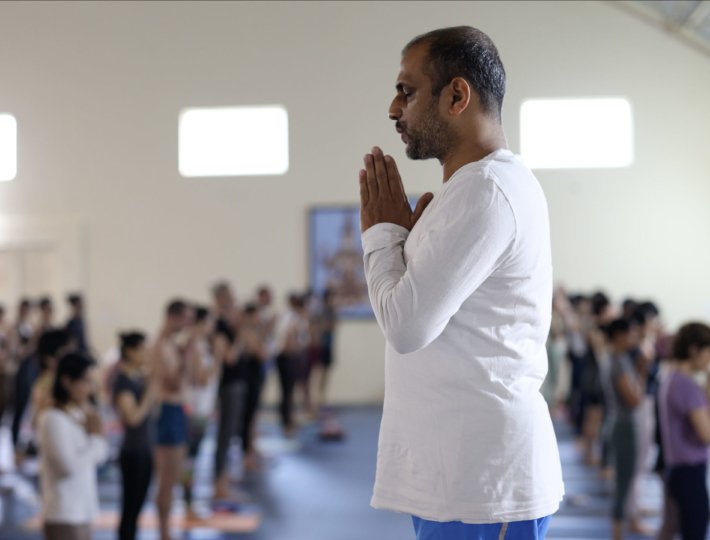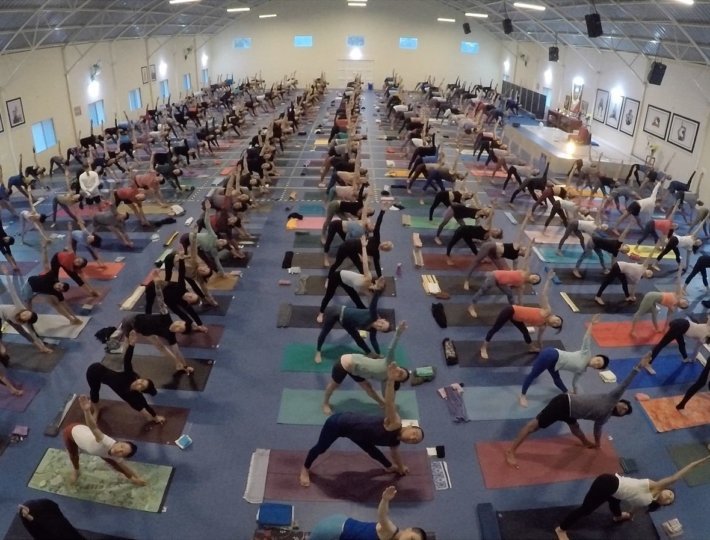I’ve been teaching mindfulness meditation for 17 years now and, to this day, the number one thing I’ve experienced with new students is that they feel overwhelmed by the sheer volume of their thoughts. Sometimes, they will sit down and, after 20 minutes of following their breath, turn to me and say, “I think meditation has made me crazier.” This leads to a somewhat awkward conversation that they may have always been “crazy,” but that mindfulness meditation is making them finally acknowledge it.
I am joking, of course; the sheer number of thoughts we have may feel crazy-making, but it’s actually quite normal to have so many each minute. In fact, meditation teachers, like Deepak Chopra, MD, claim that we have somewhere between 60,000 to 80,000 thoughts each day, so the myth that we could turn the mind off in meditation is somewhat ridiculous. Meditation is actually not a way of getting rid of thoughts, but rather developing a different relationship to them so that we can live our lives more in the present.
Imagine coming across a wild horse. You wouldn’t try to jump on it right away because it would get upset and buck you off. Instead, you might approach it, become inquisitive about it, and spend time with it a little bit every day, offering the horse kindness and respect. Then, after a period of time, you may find that you have a friendship with this animal and that it might actually allow you to climb aboard and ride around a bit. As a result of putting in all this time befriending the horse, there is a fluidity to the relationship now, and deep enjoyment of the experience.
The same can be said for mindfulness meditation practice. At first, that waterfall of thoughts is intimidating; how can we ever expect our experience to be different from that? That would be like seeing the wild horse and shrugging your shoulders, saying, “Guess this horse is a hopeless cause.” But if we show up for ourselves, offering the gift of 10 or 20 minutes each day to simply be with the breath, we are forming a different relationship to the mind.
Related: A 5-Minute Meditation to Start Building Your Practice
Every time we drift off in meditation and come back, we have a choice to scorn ourselves (“You should be better at this!”) or offer ourselves kindness (“Not a big deal. Come on back to the breath now.”) This is not unlike yelling at the wild horse to do what we say versus offering it a sugar cube to entice him to us. The latter is clearly more effective.
The more time we spend on a consistent basis meditating in this kind way, the more we notice the results. Just like with the wild horse, when we put in the time and effort, the mind gradually relaxes. It realizes it does not need to chase down the rabbit holes of every thought that arises. It can settle into resting with the breath. When that happens, we experience the same level of fluidity and ease as if we had tamed the wild horse.
This moment when we begin to settle into our meditation practice is the same one where we see that it can permeate every other aspect of our life. Because we have trained the mind not to run down every rabbit hole of thought, we are more able to be present for the simple moments of our day. These very ordinary aspects of our routine all of a sudden become extraordinary; the “extra” part is simply there because we are showing up for our life differently, in a more authentic way. We taste our coffee and are able to just be there with our coffee. We ask our spouse, “How was work?” and remain present enough to actually hear all about it. It’s a radical shift in the most nuanced moments of our day, but these moments add up to a lifetime of deep meaning and fulfillment.
No one wakes up in the morning and thinks, “I just want to space out today. I don’t want to have a genuine connection with anyone.” Yet, many of us fall into bad habits, letting our minds constantly drift off into the past or the future. We could be enjoying the most flavorful meal of our lives, holding the hand of our dear loved one, and still not enjoy it because we are mentally still clocked in at work. The magic of mindfulness practice is that it rewires the brain so when that seemingly urgent work matter pops into your head, you can acknowledge it, but return to the present moment and enjoy your meal.
My teacher, Sakyong Mipham Rinpoche, often talks about this phenomenon as our tendency to always be chasing “another now.” We aren’t able to merely be present with what is going on, whether it’s a subjectively good experience or a bad one, so we mentally check out and daydream about another moment in time, another “now” that we could be a part of.
It used to be that if you were on a long commute, you might daydream about another now, but that’s as far as you could go. With the advent of smartphones, we can quit daydreaming and leap right into it by going on social media or mentally commuting to work via our e-mail. Instead of walking down the street and enjoying the sights that are right in front of us, we could enter into a text conversation with a friend. Instead of having dinner with our spouse, we can keep track of the latest sports scores. So long as your battery stays charged, there is no need for you to ever be present, should you want to avoid the here and now. Yet, after a day of a fully charged phone, you yourself might feel drained. You spent the day spacing out, sans genuine connection.
I realize people want mindfulness to be a quick fix. I realize you want me to say, “Don’t be stressed out!” and your stress would be magically cured. I can’t, I’m sorry. But I can say that if you show up for yourself and commit to a regular mindfulness of the breath practice over a period of a few weeks, you will understand exactly what I’m alluding to here. You will see the magic of mindfulness for yourself, as you begin to show up for your everyday moments and the people in your life in a more authentic way. Just like the example of taming the wild horse, you may find that over time, you end up living a life of fluidity and ease, merely by offering yourself this mindful friendship.









Comments (0)